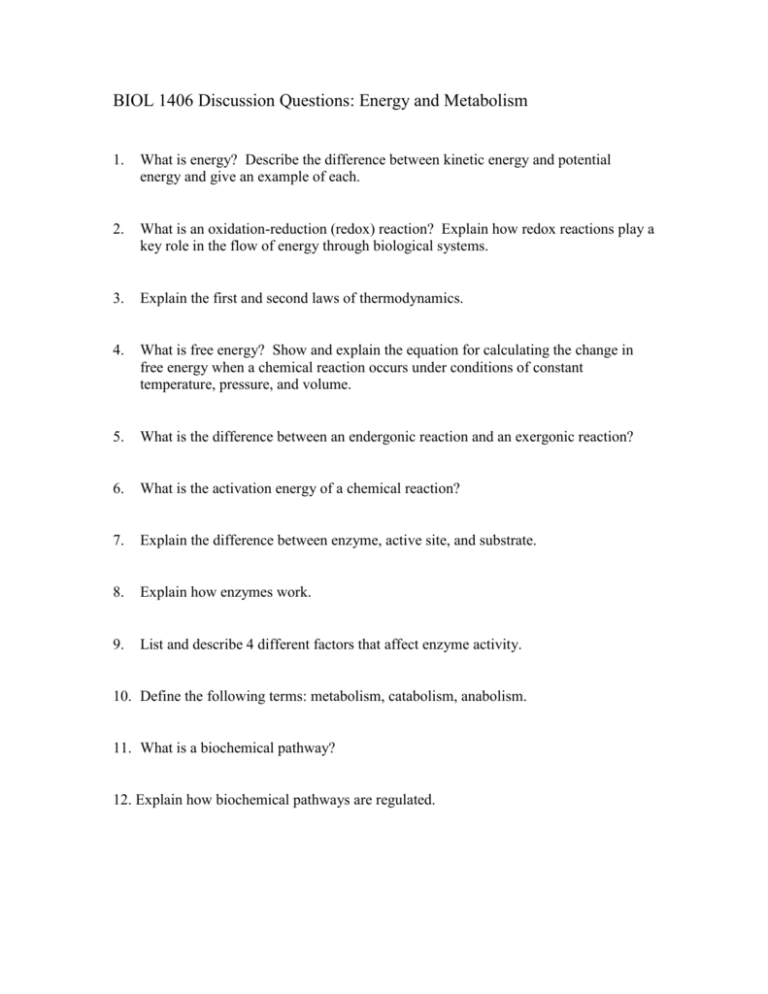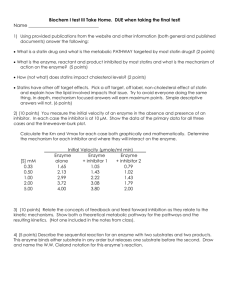4. Energy and Metabolism
advertisement

BIOL 1406 Discussion Questions: Energy and Metabolism 1. What is energy? Describe the difference between kinetic energy and potential energy and give an example of each. 2. What is an oxidation-reduction (redox) reaction? Explain how redox reactions play a key role in the flow of energy through biological systems. 3. Explain the first and second laws of thermodynamics. 4. What is free energy? Show and explain the equation for calculating the change in free energy when a chemical reaction occurs under conditions of constant temperature, pressure, and volume. 5. What is the difference between an endergonic reaction and an exergonic reaction? 6. What is the activation energy of a chemical reaction? 7. Explain the difference between enzyme, active site, and substrate. 8. Explain how enzymes work. 9. List and describe 4 different factors that affect enzyme activity. 10. Define the following terms: metabolism, catabolism, anabolism. 11. What is a biochemical pathway? 12. Explain how biochemical pathways are regulated. Use the figure below to answer questions 13-16 Reactant A Enz1 intermediate B Enz2 intermediate C end product D Enz3 13. This binding of D decreases the activity of the enzyme 1. Compound X binds to the active site of enzyme 1 and blocks its activity. Substance X is a. a substrate. b. a competitive inhibitor. c. the product. d. a non-competitive inhibitor. e. an intermediate. 14. This binding of D decreases the activity of the enzyme 1. What is substance A? a. an intermediate b. a coenzyme c. the substrate d. a competitive inhibitor e. an allosteric inhibitor 15. This binding of D decreases the activity of the enzyme 1. Compound X binds to the active site of enzyme 1 and block its activity. What is the mechanism in which once the end product D accumulates and then inhibits the enzyme 1 early in the pathway? a. metabolic inhibition b. allosteric inhibition c. reversible inhibition d. noncooperative inhibition e. feedback inhibition 16. This binding of D decreases the activity of the enzyme 1. Compound X binds to the active site of enzyme 1 and block its activity. Which of the following will reduce or overcome the inhibition of enzyme 1 by compound X? a. Decrease the concentration of reactant A. b. Increase the concentration of reactant A. c. Increase the activation energy needed. d. Lower the activation energy needed. e. Decrease the concentration of all the reactants. 17. TABLE: Energy of Reactions Reaction 1: CH4 CO2 Reaction 2: 6 CO2 6 H2O C6H12O6 6 O2 (methane) a. Is the reaction exergonic or endergonic? b. Is the reaction spontaneous? c. Is the reaction anabolic or catabolic? d. Is G (the change in free energy) positive or negative? 18. For each group of experiments, explain how the differences in experimental conditions could affect the reaction. a. You compare two side-by-side experiments. In experiment 1, you use X amount of the enzyme. In experiment 2, you use 2X amount of the same enzyme. b. You compare two side-by-side experiments. In both you use equal amounts of the enzyme. In experiment 3, you allow the products to accumulate over time. In experiment 4, you remove the products from the system as they are produced. c. In the next two experiments, you use equal amounts of the enzyme. You run experiment 5 at 20ºC and experiment 6 at 25ºC. d. In two final experiments, you use equal amounts of the enzyme. You run experiment 7 at pH 6 and experiment 8 at pH 8. 19. Suppose that you have isolated an extract from a tissue and you have found that the extract speeds up the rate of a particular reaction. What kind of information would you need to demonstrate that the substance responsible for increasing the rate of this reaction is an enzyme? Explain how this information would indicate that the catalytic effect is due to an enzyme. After an enzyme is mixed with its substrate, the amount of product formed is determined at 10-second intervals for 1 minute. Data from this experiment are shown below. Time (sec) Product formed (mg) 0 0.0 10 0.25 20 0.50 30 0.70 40 0.80 50 0.85 60 0.85 Draw a graph of these data and answer the following questions. a. What is the initial rate of this enzymatic reaction? b. What is the rate after 50 seconds? Why is it different from the initial rate? c. What would be the effect on product formation if the enzyme were heated to a temperature of 100 oC for 10 minutes before repeating the experiment? Why? d. How might altering the substrate concentration affect the rate of the reaction? Why? e. How might altering the pH affect the rate of reaction? Why? 20. A resting human (couch potato) uses 40kg of ATP in 24 hours. A weightlifter (doing hard exercise) uses approximately 0.5kg/minute. If ATP costs $30/g from a chemical company, how much does it cost a couch potato to live for a day? The weightlifter to do a 3 hour workout? 21. The following 2 equations are examples of combustion reactions: ethanol + oxygen----> CO2 + H2O + energy glucose + oxygen----> CO2 + H2O + energy How are these 2 reactions similar? 22. G (the Gibbs free energy) represents the energy change in a chemical reaction. A reaction with a positive G means energy must be absorbed for the reaction to occur. These are called endothermic reactions, and they tend not to occur spontaneously. A negative G means energy is released when the reaction occurs. These are called exothermic reactions, and tend to occur spontaneously. The equation to find G is: G=-RTlnKeq where R (the gas constant)=1.98cal/mol K T=Temperature (Kelvin) Keq=equilibrium constant=[products]/[reactants] When Keq<1 the reaction tends to be non-spontaneous Keq>1 the reaction tends to be spontaneous The second step in glycolysis is the conversion of glucose 6-phosphate (G6P) to fructose 6-phosphate (F6P). If we start with 0.020M G6P and allow the reaction to proceed, the final equilibrium mixture contains 0.00133M G6P and 0.0067M F6P. (a) Calculate Keq for this reaction (answer Keq=0.504). (b) Calculate G for this reaction (answer G=0.4kcal/mol) (c) Is this reaction endothermic or exothermic? (answer= endothermic) (d) Will it be spontaneous or non-spontaneous? (answer= non-spontaneous) 23. The Second Law of Thermodynamics states that if reactions are spontaneous they must go to jail for 2 years less a day (kidding!). It actually states that spontaneous processes tend to increase the entropy (disorder) of the universe. Why would this law favor a glucose molecule being broken down? 24.The First Law of Thermodynamics states that energy is neither created or destroyed in any process, including chemical reactions. Looking at the big picture of life, and assuming energy used by organisms comes from the sun, how does ATP production by cellular respiration obey the First Law? 25. Which of the following reactions could be coupled to the reaction ATP + H2O → ADP + Pi (-7.3 kcal/mol)? a)A + Pi → AP (+10 kcal/mol) b)B + Pi → BP (+8 kcal/mol) c)CP → C + Pi (-4 kcal/mol) d)DP → D + Pi (-10 kcal/mol) e)E + Pi → EP (+5 kcal/mol) 26. Assume that the reaction has a ∆G of -5.6 kcal/mol. Which of the following would most likely be true? a) The reaction could be coupled to power an endergonic reaction with a ∆G of +6.2 kcal/mol. b) The reaction could be coupled to power an exergonic reaction with a ∆G of +8.8 kcal/mol. c) The reaction would result in a decrease in entropy (S) and an increase in the total energy content (H) of the system. d )The reaction would result in an increase in entropy (S) and a decrease in the total energy content (H) of the system. e) The reaction would result in products (C + D) with a greater free-energy content than in the initial reactants (A + B). 27. In the following branched metabolic pathway, a dotted arrow with a minus sign symbolizes inhibition of a metabolic step by an end product: Which reaction would prevail if both Q and S were present in the cell in high concentrations? 28. Using the terms below: Option 1: Create a concept map using http://ctools.msu.edu/ctools/index.html Option 2: Create a working model using materials provided Be prepared to share with class peptide bonds proteins helix primary structure secondary structure tertiary structure pleated sheet R groups hydrogen bonds substrate or reactant (ligand) activation energy G / free energy endergonic exergonic enzymes catalysts competitive inhibitor noncompetitive inhibitor active site product allosteric regulation activator four-step enzymemediated reaction sequence or metabolic pathway (C D) intermediate compound end product feedback inhibition








